Some supermarkets back it 100%, others are just getting into it, and others still are staying far away: potatoes in paper bags. The retail sector, packaging world, and governments are wrestling with the choice: paper or plastic? Paper seems to have momentum, but will it genuinely dominate the shelves in ten years? Paper suppliers, packaging machine manufacturers, and potato packers discuss this.
Cutting right to the chase: seen over its entire life cycle, it is not so clear if paper packaging is environmentally friendlier than plastic versions. And that environmental aspect should be the driving force in choosing paper. But who decides? A survey done among packaging companies shows that the retail and trade sectors are pushing for paper. Not because the authorities (besides France) are forcing them to, or thanks to independent research. Those sectors consider consumer opinion.
Paper is seen to be better for the environment than plastic. In this article, we will not comment on the substance of that matter, which is the subject of scientific research. However, we will touch on a few points of interest and hear what sector partners have to say about why (or why not) they choose paper and what their workplace experiences are.
Environmental issues aside, packaging companies see several general downsides to paper bags. They cost twice as much (or more); there is insufficient raw material available to switch entirely to paper; it is not as strong as plastic, and does not run as smoothly through packaging machines. On the other hand, there are major advantages: potatoes have less green discoloration and paper has a substantially higher marketing value.
The Dutch potato and vegetable wholesaler, Molenaar Aardappelen en Groenten Groothandel, has been supplying potatoes in paper packaging since 2016. "We wanted to innovate, and, at that time, the world's call to banish plastic was getting louder and louder. There was also concrete demand for it,″ says Felix Molenaar. "So, we decided to switch to all-paper packaging. It was quite something, but demand gradually grew, and we're quite proud of that. It's mostly greengrocers that carry our packaged potatoes. They want to distinguish themselves from supermarkets.”
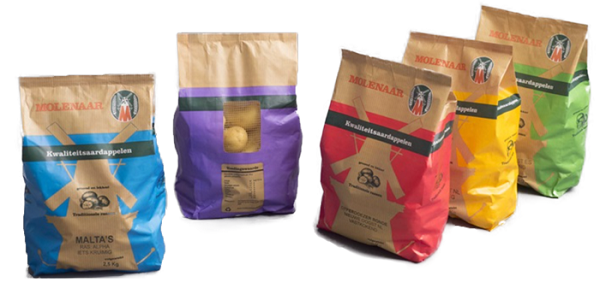 Molenaar
Molenaar
“That's not only due to the packaging but the content too. We fill our bags with tasty, traditional varieties, such as Frieslanders, Bildtstar, Doré, and Nicola. You can find the range on our website. More retailers are also offering our packaging. We began packaging [the regional specialty] Beemster Valéry in October 2021. [Company director], Astrid Francis, created a design for our existing packaging. These paper-bagged potatoes are available at [the Dutch retailer] Dekamarkt and greengrocers.″
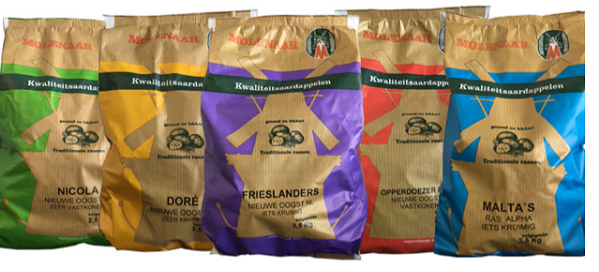 Molenaar
Molenaar
Molenaars has bags in five colours, depending on how the potatoes are to be prepared. The coloured paper is delivered on rolls, and the two and 2.5kg bags are shaped on a vertical form, fill, and seal (VFFS) machine. The wholesaler prints the name, characteristics, and barcode on those bags, in black. "It's not a quick process; we can do about 14/minute. But it doesn't need to be faster either. We're not that big, and it's not important whether 400 or 500 bags roll off the machine per hour. Our bag's mesh ventilation window is on the back. Then, when stores display the bags, the potatoes are protected from much of the light, which prevents greening. They also display well and, once empty, can go in the paper recycling bin," Felix explains.
Another Dutch company, Greydanus Aardappelgroothandel en Transport, has had 800g paper bags in its range for several years now. "We use this specifically for the smaller potatoes within the exclusive segment,″ says Klaas Greydanus. "However, most of our supply consists of the larger weights in plastic packaging. There’s no immediate demand for paper bags either.″
Greydanus' paper potato bags have a plastic window. If you want punched holes, they must have a particular shape, and specific paper strength is required; otherwise, the bag will tear. "Plastic is cheaper and runs better over the machines. We've been working with recyclable plastic for about 15 years. And have you ever seen a potato bag flapping around on the side of the road? They're always nicely sorted,″ he says.
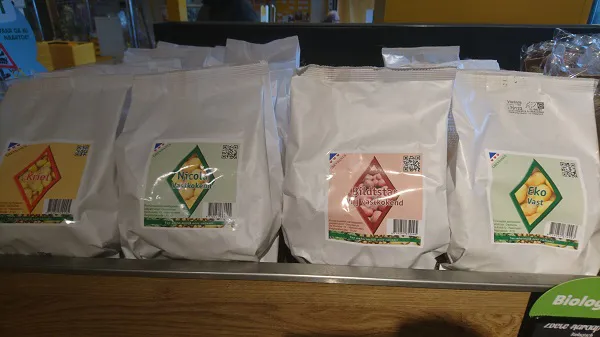
Greydanus
Belgian retailers had turned their gaze on paper fruit and vegetable packaging before those in the Netherlands. Even now, that country has a significantly larger supply. The Belgian company Semoulin Packaging supplies pre-made bags and rolls of paper to various sectors, including several potato packing businesses. "We manufacture block bottom bags and cut and print rolls of paper to size. We can print up to ten colours,″ says Robert Schram. "We use mainly multilayer and Kraft paper for our (semi-)-finished products. The rolls can be 100% paper but we also use material with an eco-friendly water-based coating, a layer of varnish needed to seal the bags on the VFFS machine.”
“Bags with mesh windows are in high demand, not only for potatoes but also for products like onions and carrots. That window provides ventilation, and shoppers can see what they're buying. You can get this with punched holes too, but we don't presently do much of that. Our current machines work best and fastest for producing paper rolls with net windows. We can reach speeds of up to 500m/minute. It's also quite hard to suck out all the paper waste produced in the perforating process. But when the demand comes, we'll take it on.″
In Belgium, paper packaging may contain 15% non-paper material and still be deemed recyclable. In the Netherlands, that can only be five percent. "We produce one and two-kilo paper potato paper bags for a Dutch packer that supplies a major supermarket chain. Initially, we thought of making a bag with a net window. But, with that made of cellulose fibres, the ink, and the coating to seal the bag, you quickly exceed that five percent. So, in the end, we ended up with perforated bags,″ adds Robert, who points out that you can pack up to 2.5 kilos well using rolls of paper.
"More than that, and it becomes tricky. After all, the potatoes fall from quite a height, and then the packaging has to hold. It's not the net or the holes that are a problem, as the paper is of a certain thickness; it's the seams; they can tear. That's not an issue with pre-made bags, as the bag is simply placed on a belt. It can hold up to 20kg. In Ireland, for example, and sometimes the United States, you can find potatoes in up to 10kg paper bags.″
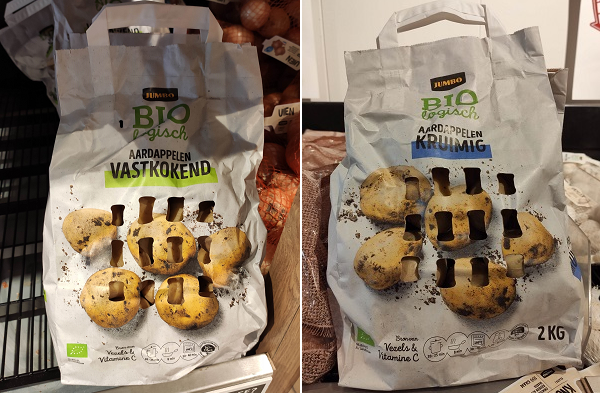
Semoulin
Robert says it is primarily organic potatoes that are packaged in paper. "You have a better margin with those, so can better compensate for paper's higher price. One of my clients, who has switched to paper, does two million bags a year.″ Besides the cost price, which has risen sharply since the pandemic broke out, delivery times are the sector's biggest challenge. "To respond to this, we let our customers place orders a year in advance. We then order the paper and reserve a spot in our production planning. We plan deliveries at a later stage."
Semoulin supplies various paper qualities in matt and gloss. That quality determines how smoothly the material runs on a packaging machine. "You can apply a water-based varnish coating to the outside, making the paper glide better on the machines. And, of course, you need a good machine. The right material and methods will bring you a long way," Roberts says.
Jan Strijbos, sales manager at Rovema Benelux, a packaging machine manufacturer, agrees that packaging issues are due in equal part to the technology and materials. He says that since smooth paper slides easily through machines, builders prefer finding solutions for perforated rolls. Retailers and shoppers prefer a bag with a net window because of its sturdiness and good product visibility. "We displayed a machine at Interpom that uses VDH Concept-perforated Mondi paper.”
“It can shape and fill 120 bags per minute on one tube. Few weighers can handle those speeds. This machine uses 1kg pillow bags for potatoes. The end product is just as attractive and sleek as using foil," says Jan, who points out that paper is, undoubtedly, less robust than plastic. "And the thicker and stronger the paper, the harder the machine has to work."
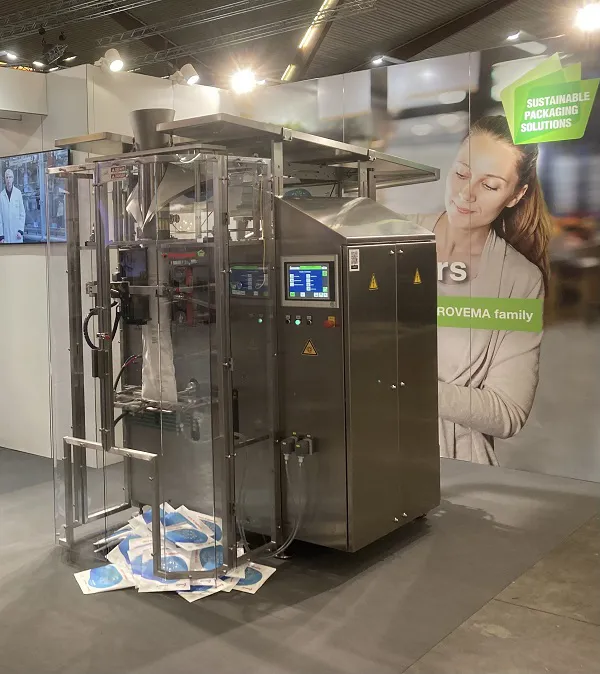
Rovema
Rovema offers solutions for paper with a sliver of sealant - a food-grade PE layer that is also a moisture barrier - on the bag's end or over its entire surface. Besides this, this company has the technology to hot melt bags' ends together, so only 100% paper is used.
"Many think paper is better for the environment. However, considering the impact throughout the chain, I'm convinced perforated PE bags perform better. After all, you also have to produce paper, and filling them usually uses way more energy than filling plastic bags. But it's about perception: plastic has become Public Enemy No. 1. That's why we developed a flexible machine that can run both paper and PE. Clients can then switch from one to the other according to the market requirements,″ says Jan.
VDH Concept, a Belgian company, prints and die-cuts rolls of paper. "We don't want to comment on paper versus plastic's effect on the environment. But, it seems we're getting more demand for paper from all over Europe every day. Even though PE or OPP film is cheaper and has better delivery times,″ says Jan Lode Van Den Heuvel. "The Netherlands still largely opts for plastic, but Belgium focuses more on presentation and experience."
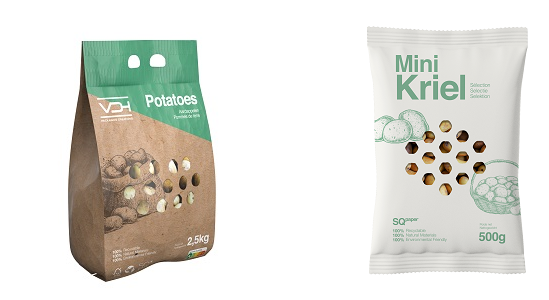
VDH Concepts
European standards are moving toward paper packaging raw material consisting of 95% paper, explains Jan Lode. "We work with perforations because we assume mono-material will be the norm within a few years. That means you'll no longer be able to include a net window, only the coating that renders the packaging more food safe and seals it. We use certified Mondi paper and have our own brand on the market: SQ paper. We can also do tailor-made perforation and always ensure the product is highly visible.″
VDH Concept uses 84 and 136g paper. "Though I find the second option a little too heavy. It serves for the larger packaging and isn't that much in demand. We can punch up to 2.5 kg pillow bags with 84-gram paper. The thinner, the better for the environment," Jan Lode explains.
From Belgium, back to the Netherlands, where potato specialist, Landjuweel's Michiel Meijering is still undecided. "Paper seems a good, perhaps sustainable, short-term option, but our investment readiness' primary focus is on future-proof packaging techniques.″
Michiel's long-term belief lies with plastic. "Paper can be recycled at most, seven times. So you often need new virgin raw material. You'd have to plant millions of trees if the entire packaging industry were to focus on paper. But trees need time to grow, and the current supply is already limited. That will also likely become a bigger problem in the long run. On the other hand, if we further refine the plastic process and its supporting regulations, we can continue recycling it indefinitely. Oil supplies are finite, so, as a by-product of petroleum refining, virgin plastic is too. But, the world has so much plastic already that its recycled, raw material supply is guaranteed.″
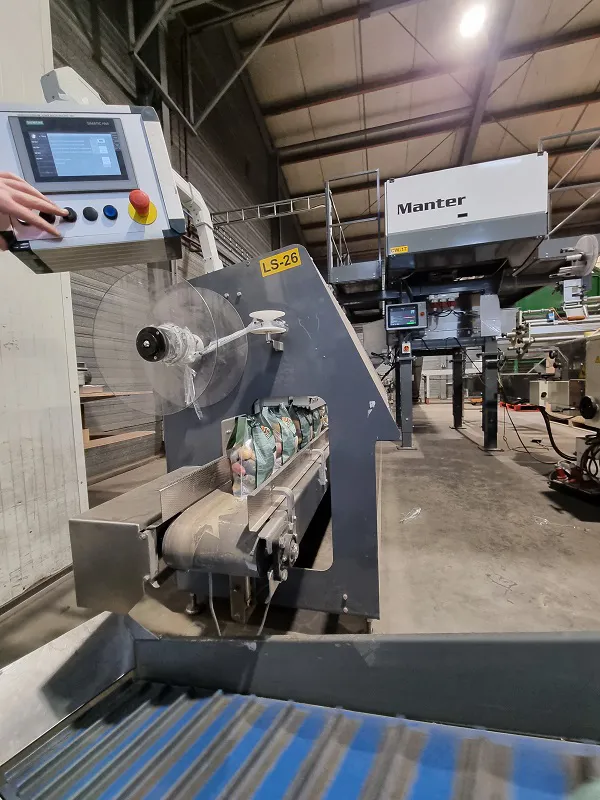
Landjuweel
"Even now, plastic is winning the argument, especially in the Netherlands. It's estimated that less than one percent of Dutch supermarkets' potato packaging is paper. It's mostly local, specialty, and organic products that are packaged in paper. Plastic is cheaper, offers added value in terms of shelf life, and allows a higher production rate for packaging. Though, it's probably only a matter of time before technology catches up with that. Price difference-wise, people are gradually becoming more willing to pay more for sustainable products. Paper should grow slightly, which is why we're looking into how we can adjust our existing machinery. We want a flexible solution.″
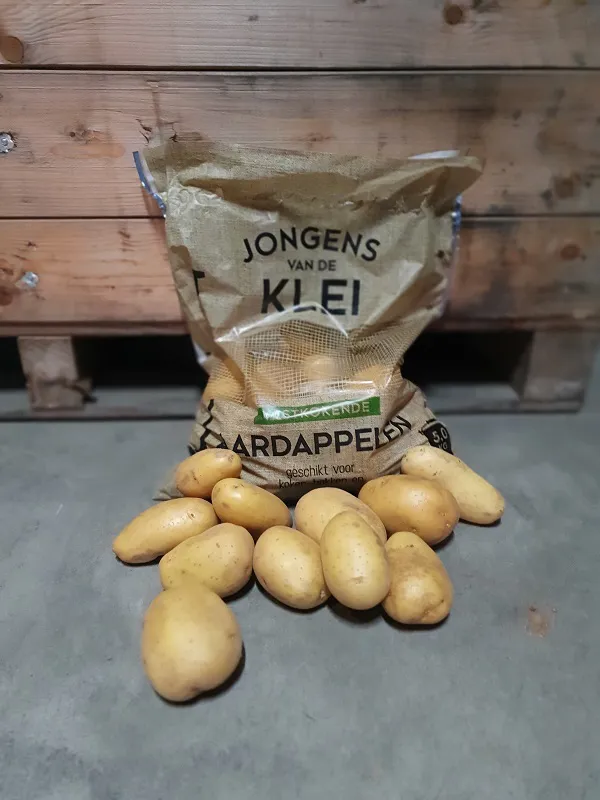
Landjuweel
Are there alternatives? "Not right now. Jute is durable but incredibly expensive. And, with loose products, you have the problem of shelf life - for potatoes, especially greening - and that it's harder to stand out using a brand or specific variety. Packaging-free is a great idea, but that target group is small,″ says Michiel.
And back to Belgium - where Stefaan Spriet of Spriet Aardappelen recently purchased a new Rovema machine. "It's performing well. We've had paper bags with net windows and handles on offer since last year. It was an own initiative, not based on a retail or trade request. The sustainability theme keeps us busy. For example, we have 2,400 solar panels, and we do heat recovery. Yet, there's still work to be done in several areas before paper packaging can become a success story.”
“And it's not always clear whether, ultimately, it will be an environmentally friendlier solution than the thin plastic mono-material you already find in several supermarkets. Both have their pros and cons. We do get positive reactions from our clients, who are happy they can offer paper packaging to their customers." Besides sealing the bags with a coating, Spriet Potatoes uses pre-sewn bags to seal its organic paper packaging. "Humidity can be a problem; the bags tend to collapse in the cold stores. But, once in supermarkets' dry environment, the paper restiffens nicely," Stefaan says.
Dutch packaging specialist Paardekooper supplies potato packers with coated paper from German paper manufacturer, Cartomat. "We already have seven years of experience with coating and can deliver relatively quickly,″ says Ronald Borst. "The rolls are compatible with most VFFS machines and achieve high stroke/minute rates. Our wet strength paper, certainly a must for potatoes and onions, is mechanically, not chemically reinforced. For food safety reasons, we only use virgin paper. Recycled paper could, after all, come from anywhere. Initially, the paper rolls weren't very popular because of what they cost.”
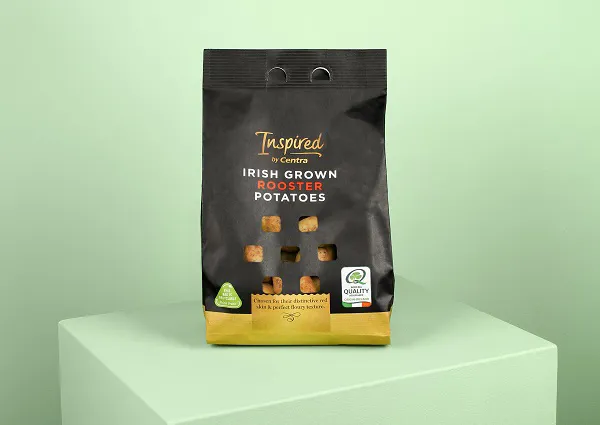
Paardekooper
“That market is now picking up, but it's usually not at the packers' request. It’s retailers who explicitly ask for this product, because of consumer experience. Plastic has a negative image due to the oceans' plastic soup, but some fruit and vegetable products must be packaged in plastic to prevent food waste. We just all have to use it in a good end-of-life manner. Also, paper production emits a lot of CO2, and because its fibres keep shortening, it's not endlessly recyclable. Eighty percent of the packaging material we supply is still plastic-related.″
"Our main paper product is 100g paper for 2.5kg packages. The paper can’t be too thick because it acts as a thermal barrier for the sealing bar, whereas with plastic, you need only minimal heat to seal the bag. The paper rolls can be position-printed with the water-based varnish only where the bag is sealed, or its entire surface can be coated. That's useful for rolls of paper used for multiple formats because no matter where you seal, it's coated. The hole pattern is unique to us. Then you don't need a net window. Though, you could use a degradable, entirely recyclable cellulose net. Still, we believe the purer the paper, the better it is for recycling," says Ronald.
Paardekooper supplies Warnez. This Belgian company was looking for a paper roll for 2.5kg bags on behalf of a local supermarket. "Preformed paper bags have been around for a long time, and many packers work with them,″ says Peter Van Steenkiste. "We, too, have these bags from Semoulin. We've been sourcing paper on rolls for packaging without folding from that supplier since March 2019 at the behest of another customer. Tests showed that kraft paper wasn't sturdy enough for what we wanted; we needed white paper.”
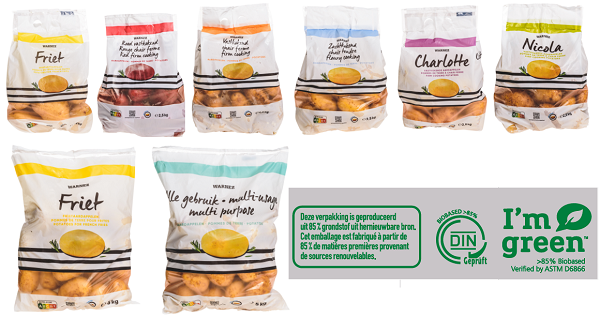
“In April 2021, we were the first company in Belgium to come out with a 2.5-kilo bag from a roll. It's only coated where it's sealed, thus achieving the 95% standard. Paper is weaker than plastic, and the handle might well break, but the bag is generally reasonably sturdy. We use 100g for the 2.5 kg bag and 80g for the 1kg one. We have die-cut packaging and bags with cellulose nets, which can both be recycled. Our line is automated for the 1kg bags. But, since there's always a risk of tearing, we don't use the robot arm to pick up the 2.5 kg packages and place them in the crate. That doesn't happen often, but even one in 500 is already too much.″
In the paper segment, Warnez would like to switch entirely to paper rolls. "We can only achieve a 12 per minute stroke rate with preformed bags; 'on the roll'; it's easily twice that. But our existing paper roll machine cannot yet handle large calibres. We're currently busy modifying that machine's tube and shoulder to be able to pack using only rolls. The cost price also plays a role here,″ continues Peter, who never advises paper-on-a-roll packaging himself. "We offer it when customers ask for it. And perhaps, in the future, the government will issue guidelines in this respect. Income-wise, it's a step backward because of the higher production costs, which we cannot fully pass on. Not only is the raw material twice as expensive, but the production speed is also 30% lower and requires more manual labour.”
“Also, paper takes longer to deliver than plastic. So, you have to keep a larger stock. But you can't stretch that indefinitely because clients may want to change something about the packaging design. And is paper really more environmentally friendly? We did specific research to compare 2.5kg paper, PE, and bio-based PE bags. Based on that Circopack project done with UGent, we indisputably concluded that paper packaging for 2.5kg potatoes affects the environment more than PE and bio-based PE. We used the current LCA methodology and the initial results to determine that. Please note: this is specific to 2.5kg potatoes and should not be generalized to other products or weight classes."
For Warnez, Peter considers bio-based PE to be more beneficial. "It consists of more than 85% sugar cane and can be recycled like regular PE. It costs twice as much as PE but is still cheaper than paper, it runs well on the machines, is thin, and it's a great story for clients and the general public to get behind," Peter says.
Existing VFFS machines often have to be tweaked to be able to process paper. That is something to which Mark van der Kamp of Sarco Packaging can attest. This Dutch company distributes, among others, ILAPAK VFFS Packaging machines and supplies the accompanying plastic and paper packaging materials from Gameren. "It's not just plug-and-play and not all existing VFFS machines can be used for paper. Often a new pipe has to be fitted, and an overpressure system mounted on the chisels. Those buying new machines, however, can purchase a line they can use for PE, hard plastics (OPP/PP), and paper.”
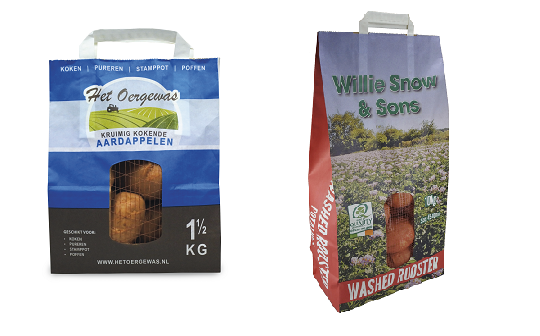
Sarco
“There's certainly market interest for that from a sustainability perspective. In that sense, there's an even greater demand for thinner plastic solutions that can be run on existing machines. For example, we now supply a 70-gram paper solution with a water-based heat-sealable varnish as the sealing medium. That means we stay above the 95% paper level, and you can recycle it. Besides paper from rolls and preformed paper bags, we also supply standard films and films made from renewable materials (Green PE). So, we have a broad, good view of the market,″ explains Mark.
"Paper is a fantastic material: you can print on it, it has a very natural appearance, has a nice texture, and looks great. For potatoes, it also blocks UV rays, which causes greening. But there's a limited raw materials flow, and our sector isn't quite ready for it yet. Previously, the amount of bark, offcuts, and sawdust from the wood industry was sufficient to produce paper; now, you need whole trees to meet demand. There aren't enough of these, which is driving prices up. Just like the energy sector, the paper industry already works with daily prices. And the market is restless.”
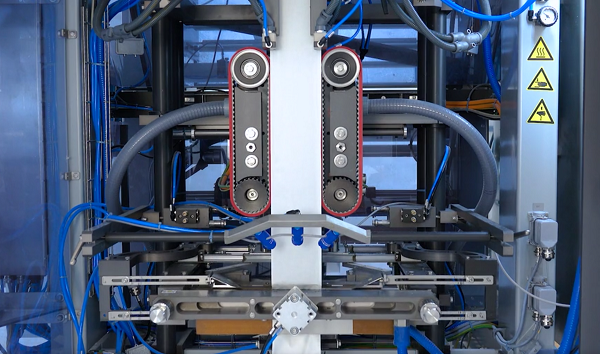
Sarco
“A 2.5kg plastic bag for potatoes costs around €0.05; the paper ones cost at least 2.5 to three times as much. Every fruit and vegetable processor or packer who supplies paper runs up against that cost price. Customers will never fully reimburse that, along with the increased staff hours and lower production speed. And how sustainable is paper really? How many gallons of water do you need to make it? And what chemicals to get it white? It all sounds nice, but the boom is coming from a consumer perspective. Since we've been doing so for much longer, people are also quicker to recycle paper than plastic," Mark concludes.
Where will the sector be in ten years?
"Paper will undoubtedly remain much pricier than plastic, and I doubt the sector will become much more enthusiastic. Paper is also simply a difficult material to package. In France, paper packaging is again exceeding the minimum 100g plastic content threshold. I expect the Dutch supermarket landscape, where price is king, to remain at 80% PE film,” says Mark. “In Belgium, it should become a 60/40 or even 50/50 ratio for PE versus paper, in favour of PE, with smaller packages and organic in paper,″ is Jan Lode's (VDH Concept) prediction. "Paper won't dominate, though much depends on European legislation regarding packaging,″ believes Paardekooper's Ronald.
"I wonder about that too," says Michiel (Landjuweel). “If I knew the answer, I'd invest in that direction right away. But, to answer the question: I expect more paper, with most of the sector sticking to PE.″ Semoulin's Robert has been of this opinion for a few years now: "The trend in Europe is less and less plastic. Carrier bags have to go by 2025, and that trend will continue. I think several countries will follow France in their ban on plastic for fruit and vegetables weighing less than 1.5kg.”
“But I also think governments should use grants to encourage the switch so that paper bags, for products that can be packaged in paper, no longer have to cost more than plastic ones. Because consumers often still choose the cheapest solution. And just as the plastic industry continues to develop, I also see the paper industry making an environmental leap because that technology isn't stagnant; it must advance."
Molenaar Aardappelen
info@molenaardappelen.nl
www.molenaaraardappelen.nl
Greydanus aardappelgroothandel & transport
info@greydanus.nl
www.greydanus.nl
Semoulin
robert.schram@semoulinpackaging.com
www.semoulinpackaging.com
Rovema Benelux B.V.
Jan.Strijbos@rovema.nl
www.rovema.nl
VDH Concept
jan@vdhconcept.com
www.vdhconcept.com
Landjuweel B.V.
M.Meijering@landjuweel.nl
www.landjuweel.nl
Spriet Aardappelen
stefaan@sprietaardappelen.be
www.sprietaardappelen.be
Paardekooper
info@paardekooper.com
www.paardekooper.nl
Warnez Potatoes
info@warnezpotatoes.be
www.warnezpotatoes.be
Sarco Packaging
info@sarcopackaging.com
www.sarcopackaging.com
